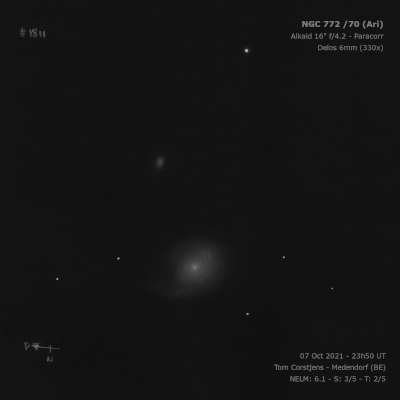
William Herschel discovered NGC 772 = H I-112 = h181 on 29 Nov 1785 (sweep 481) and logged "cB or vB, L, R, mbM, 3 or 4' dia, difficulty resolving. In the most resolvable part a faint red colour perceivable." On 3 Nov 1855, R.J. Mitchell wrote "...One branch in particular strongly suspected as at A [in diagram] curved towards the * preceding." This description refers to the northern spiral arm and star preceding (indicated on the diagram) is the HII region NGC 772:[HK83] 57, from Hodge & Kennicutt's "An Atlas of H II regions in 125 galaxies". It was also noted by Dreyer on 9 Jan 1875: "An eeF neb point was by glimpses seen by both observers in Pos 315° +/, Dist. 2' +/- from [GC] 463."
200/250mm - 8" (10/4/80): fairly faint, fairly large, oval, bright core, two mag 11 stars to SE.
300/350mm - 13.1" (11/5/83): bright, moderately large, slightly elongated, sharp concentration. Forms a close pair with NGC 770 3.5' SSW.
400/500mm - 18" (12/3/05): bright, very large, elongated 4:3 WNW-ESE, roughly 4'x3'. The halo is asymmetric and more extensive on the NW side with a very strong impression of a spiral arm attached on the north side and sweeping to the west (confirmed on image). Forms a pair with much fainter NGC 770 3.5' SSW.
600/800mm - 24" (9/7/13): bright, very large, elongated 5:3 WNW-ESE, 4'x2.5'. Strongly concentrated with a very bright oval core. The halo is clearly asymmetric and more extensive on the NW side. With careful viewing a long arm is visible at 200x extending from the central region towards the NW. The arm is better separated from the main body at 450x and ends near NGC 772:[HK83] 57, a slightly brighter HII knot that appears as an extremely faint, "soft" star.
900/1200mm - 48" (11/1/13): very bright, very large, elongated at least 5:3 WNW-ESE, ~5.4'x3', sharply concentrated with a blazing core that increases to the center. Contains two spiral arms, though dominated by a bright, long arm that attaches to the core on the east side, wraps counterclockwise to the north of the core and then extends in a fairly thin arch to the west. The arm extends over 3' in length and ends at the northwest tip of the galaxy, ~2.5' from the center. It contains 1 or 2 very faint HII knots. A second low contrast arm begins at the south end of the core and spirals out clockwise to the east. This arm is broader and does not have a sharply defined edge but was fairly easily visible. The outer halo to the southeast of this arm has a very low surface brightness. Forms an interacting pair with NGC 770 3.5' SSW. PGC 212884 (8x the redshift) was easily picked up 5.8' SW and appeared fairly faint, small, round, 18" diameter.
Notes by Steve Gottlieb